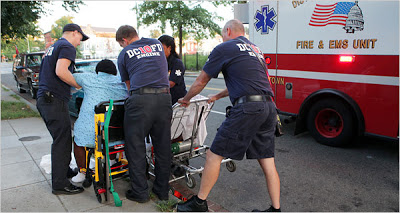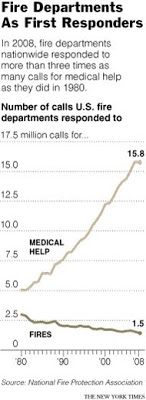Firefighters Become Medics to the Poor
By Ian Urbina / September 3, 2009
WASHINGTON — Peeling off his latex gloves after treating a 4-year-old boy having a severe asthma attack, J. R. Muyleart sighed with a touch of frustration. It was 3 a.m. and in the past 24-hour shift, Mr. Muyleart, a firefighter, had responded to at least one emergency call per hour.
But only two of those calls were for fires; most of the others involved heart attacks, diabetic sores, epileptic seizures and people complaining of shortness of breath.
“I joined the force to battle blazes, not to be an emergency room doctor,” Mr. Muyleart, 35, said as he and the rest of Engine Company 10 drove back to their firehouse, which for most of the last 15 years has been the busiest in the country, according to industry surveys.
Among the hidden costs of the health care crisis is the burden that fire departments across the country are facing as firefighters, much like emergency room doctors, are increasingly serving as primary care providers.
About 80 percent of the calls handled by Engine Company 10 are medical emergencies because the firehouse serves one of the city’s poorest areas, where few residents have health insurance, doctors’ checkups are rare, and medical problems are left to fester until someone dials 911.
In many big cities, the problem is compounded by budget shortfalls that have led to the elimination or proposed elimination of 6,000 firefighter jobs in the past year, or about 2 percent of all firefighters, according to the International Association of Fire Fighters. At the same time, emergency calls have increased by 1.2 million, or 3.5 percent, compared with the year before.
Washington’s fire department, which has not faced major layoffs, is dispatched along with Emergency Medical Services to almost all emergency calls in the belief that it can provide the quickest response. It gets more such calls per capita than just about any other fire department in the nation, and a disproportionate number come from poorer neighborhoods like Trinidad, where Engine 10 is based, in the Northeast section of the city.
In New York City, only about 45 percent of the 473,335 calls answered by firefighters last year involved medical emergencies. The city’s Emergency Medical Service handles most medical calls, responding to 1.2 million last year.
Last year, Engine Company 10 handled more than 6,500 calls, about three times the national average, according to Firehouse Magazine. The relentless pace is one reason firefighters across the country compete for a chance to work at the firehouse, which is nicknamed the House of Pain.
“We get our share of fires here,” said Leo Ruiz, 35, as he finished his breakfast after returning from a call involving a woman with abdominal pains. “But what makes this place different is that in the down time you have to be running 24 hours straight to keep up with all the other calls.”
Suddenly, another firefighter yelled “Box!” Within 10 seconds, the fire engine was rolling, four firefighters on board, heading to the day’s first “box alarm,” or building fire.
“This is what we live for,” Mr. Ruiz said as he put on his oxygen tank.
At the scene, flames spilled out of a window. In 10 minutes the blaze was under control.
Shortly after returning to the firehouse, Engine Company 10 was dispatched again. “Man down, possible seizure,” the dispatcher said, to groans from several firefighters.
In the next 24 hours, the company took three calls involving asthma attacks, five for chest pains or shortness of breath, two for assaults and six for unconscious people on the sidewalk. The only other fire was a small one in a trash hauling bin.
“Guys complain about all the medical calls, but to me it’s work,” said Lawrence Jones, 24, a firefighter who grew up in the neighborhood and has been on the force two years.
Indeed, the shift in firefighters’ duties, which has been occurring for decades, is not without its up side for fire departments.
Advances in consumer protection rules and fireproofing technology have led to a drop in the frequency of fires, so medical emergencies have helped keep firefighters employed.
Fire departments nationwide responded to almost 1.5 million fire calls in 2008, compared with 3 million in 1980, according to the National Fire Protection Association. Fire departments went on about 15.8 million medical calls in 2008, up from about 5 million in 1980, a 213 percent increase. The shift has occurred as cities realized that firefighters could respond more quickly than ambulances, and more cities trained firefighters as emergency medical technicians.
For Engine Company 10, drug addiction and violent crime are added reasons there are so many medical emergencies. Last year, the neighborhood had so many drug-related shootings that the police set up checkpoints to inspect cars that entered or left the area.
Around 3 p.m., a call took Engine 10 back to 14th and H Streets, northeast. The corner is known by the firefighters as the “vortex of sickness” because the dispatcher sends them there five or six times per shift.
“Drug overdoses, passed-out drunks, car accidents, heart attacks, seizures,” said Lt. Donald Mayhew, a fourth-generation firefighter. “It all converges right here.”
The four firefighters from the House of Pain arrived first to find a glassy-eyed man lying drunk on the sidewalk. Soon the police and an ambulance arrived, but the firefighters were already checking the man’s vital signs and trying to persuade him to stand up and move along or go to the hospital. Eventually he stood and stumbled away.
“Look around,” Mr. Muyleart said. “We have an ambulance and two cop cars here. Do we really need a fire engine and four firefighters as well?”
Some cities have questioned the cost of dispatching fire engines to medical emergencies, but most have determined that it is too risky not to always send the closest emergency personnel.
In St. Louis, Emergency Medical Services and the Fire Department merged in 1997 to save money. But the city fire chief, Dennis M. Jenkerson, still sends fire trucks on most medical calls.
“People call and say, ‘I’m having trouble breathing,’ ” Chief Jenkerson said. “Can they afford to wait five and a half, six minutes, for an ambulance? No. Seconds count with most medical emergencies.”
Most other departments also dispatch fire trucks to medical calls because firefighters are trained emergency medical technicians, cities have more fire trucks than ambulances, and fire stations are located throughout the city, said Lori Moore-Merrell of the International Association of Fire Fighters.
“If it’s a serious medical call, a fire, we sprint, regardless,” Mr. Muyleart said as he hustled to the truck after a caller reported chest pains. “It just seems like so many people use us as their primary care providers.”
[Al Baker contributed reporting from New York.]
Source / New York Times




















That is because the ER cannot turn down anyone that enters it. That is one of the reasons that there is a huge waiting time for going there. The only exceptions are major traumas that get to go in right away.
I doubt that people will be willing to spend almost a entire day in the ER just for routine medical care.
It is hugely common, especially in rural and small town Texas, at least, that ambulance service is privately operated, and, while it may be contracted for by municipalities, is quite expensive and often involves long delays.
In 2002 my elderly aunt fell in her Cleburne home and broke a hip. I found her on the kitchen floor some time later and called 9-1-1. Cleburne firemen, who are public employees, responded within minutes and were really great, checking her vitals, making her more comfortable, and staying with us for OVER AN HOUR until an ambulance could arrive.
IMHO, this is another example of thre superiority of public employees and agencies in dealing with people’s most basic needs on a not-for-profit basis.
Emergency rooms would not be so crowded if every MAJOR hospital provided them, but many choose to focus on more profitable health care delivery, leaving the poor to crowd into publicly-subsidized facilities.
There’s definitely a problem here, but it’s not the one the article identifies.
In most cities, there aren’t so many fires anymore due to better building codes & construction, sprinkler systems, etc. In San Francicso, for example, between 60% and 80% of 911 calls are medical, if I remember correctly.
While it’s true that many people aren’t getting health care through their doctors and therefore rely on EMS, the real problem is that cities hire too many firefighters and not enough medics, and buy too many fire engines and not enough ambulances.
I’ve done EMT training along with the fire trainees in SF. Many are young men (often of color), training for their first job out of high school. They want to be fire fighters because it’s an exciting, admired, and well paid job (and, for some white ethnic groups, a family tradition). They are required to get at least EMT training to have a shot at the FD, and their chances improve if they also complete paramedic training.
But most of them don’t really want to be medics. Especially medics who focus on diabetic bedsores or acting as taxi service for chronic inebriates. A large proportion of emergency medical calls will be for chest pains and shortness of breath, regardless of how many people have good health coverage. And people (like myself, if I were younger) who want to be medics often don’t want to be firefighters.
EMS systems need to be split up and resources should be allocated where they’re most needed. Union rules have a lot to do with why a fire engine is sent out in addition to an ambulance for medical calls (in SF & other cities, they’re stationed at the same firehouses, so it’s not an issue of response time).
Not to mention, citizens have romantic notions about firefighters. No one wants the local firehouse to close, even if it fights only 2 fires a month and a team from the next neighborhood over would take only 30 seconds longer to arrive.
And so it goes….
Also it seems that they now have to be NREMT-B rather then a State EMT license too on a side note.